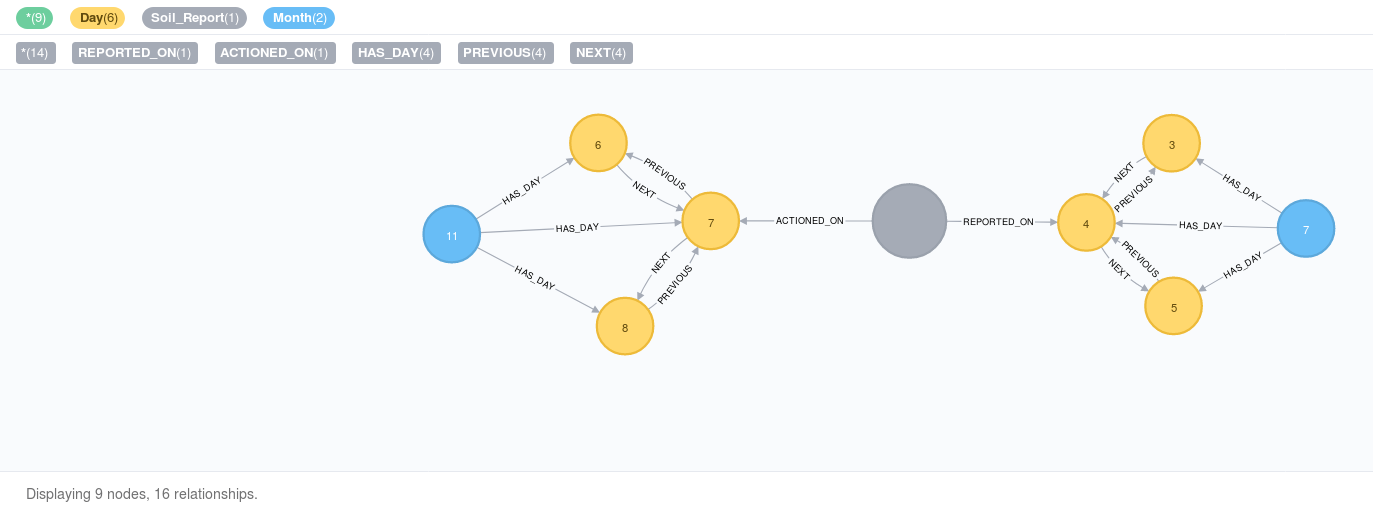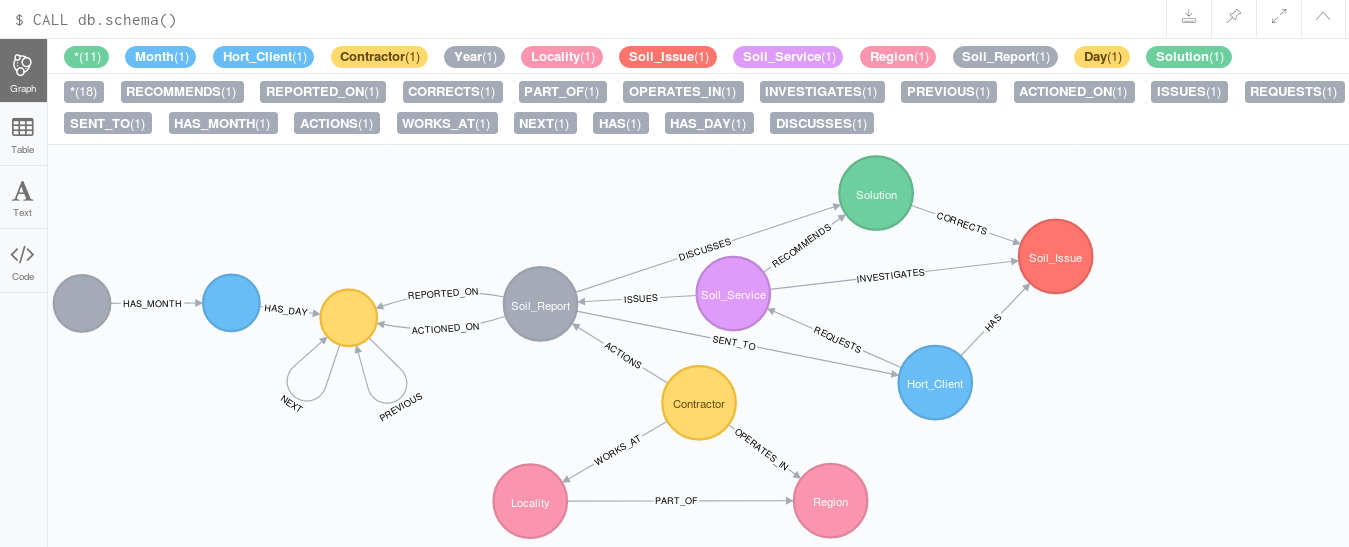Prerequisites:
Background
Now that we have the time tree in place, let’s bind Soil_Report node using data from its two properties, action_date and report_date to specific year-month-day nodes on the time tree. As a reminder let’s review the current property list for a Soil_Report node:
{
"recommendation": "4082",
"action_date": "2013-08-12",
"client": "157",
"days_delayed": "56",
"soil_analyst": "7320",
"report_date": "2013-06-17"
}
We will go step by step to understand exactly how this node binding works.
1. Retrieve date-related properties fron the node
- As a test run we’ll use a very specific
Soil_Reportnode
MATCH (s:Soil_Report{client:'171', recommendation:'6689', soil_analyst:'576'})
RETURN s.action_date, s.report_date, s.days_delayed
Output:
╒═══════════════╤═══════════════╤════════════════╕
│"s.action_date"│"s.report_date"│"s.days_delayed"│
╞═══════════════╪═══════════════╪════════════════╡
│"2011-11-07" │"2011-07-04" │"126" │
└───────────────┴───────────────┴────────────────┘
2. Split each date property string into a list of strings
- Note that both dates have been written to the graph as strings, e.g. “2011-05-14”
MATCH (s:Soil_Report{client:'171', recommendation:'6689', soil_analyst:'576'})
WITH s, split(s.report_date, '-') as reported_on, split(s.action_date, '-') as actioned_on
RETURN reported_on, actioned_on
Output:
╒══════════════════╤══════════════════╕
│"reported_on" │"actioned_on" │
╞══════════════════╪══════════════════╡
│["2011","07","04"]│["2011","11","07"]│
└──────────────────┴──────────────────┘
3. Assign each string value to a separate variable
- Note that both dates have been written to the graph as strings, e.g. “2011-05-14”
MATCH (s:Soil_Report{client:'171', recommendation:'6689', soil_analyst:'576'})
WITH s, split(s.report_date, '-') as r_on, split(s.action_date, '-') as a_on
WITH s, r_on, a_on, toInteger(r_on[0]) as r_year, toInteger(r_on[1]) as r_month, toInteger(r_on[2]) as r_day,
toInteger(a_on[0]) as a_year, toInteger(a_on[1]) as a_month, toInteger(a_on[2]) as a_day
RETURN r_year, r_month, r_day, a_year, a_month, a_day
Output:
╒════════╤═════════╤═══════╤════════╤═════════╤═══════╕
│"r_year"│"r_month"│"r_day"│"a_year"│"a_month"│"a_day"│
╞════════╪═════════╪═══════╪════════╪═════════╪═══════╡
│2011 │7 │4 │2011 │11 │7 │
└────────┴─────────┴───────┴────────┴─────────┴───────┘
4. Matching variables to specific time tree day nodes
MATCH (s:Soil_Report{client:'171', recommendation:'6689', soil_analyst:'576'})
WITH s, split(s.report_date, '-') as r_on, split(s.action_date, '-') as a_on
WITH s, r_on, a_on, toInteger(r_on[0]) as r_year, toInteger(r_on[1]) as r_month, toInteger(r_on[2]) as r_day,
toInteger(a_on[0]) as a_year, toInteger(a_on[1]) as a_month, toInteger(a_on[2]) as a_day
MATCH (y:Year {year:r_year})-[:HAS_MONTH]->(m:Month {month:r_month})-[:HAS_DAY]->(r_d:Day {day:r_day})
MATCH (y1:Year {year:a_year})-[:HAS_MONTH]->(m1:Month {month:a_month})-[:HAS_DAY]->(a_d:Day {day:a_day})
RETURN y,m,r_d, y1, m1, a_d
Output:

5. Binding time tree day nodes to Soil_Report node
MATCH (s:Soil_Report{client:'171', recommendation:'6689', soil_analyst:'576'})
WITH s, split(s.report_date, '-') as r_on, split(s.action_date, '-') as a_on
WITH s, r_on, a_on, toInteger(r_on[0]) as r_year, toInteger(r_on[1]) as r_month, toInteger(r_on[2]) as r_day,
toInteger(a_on[0]) as a_year, toInteger(a_on[1]) as a_month, toInteger(a_on[2]) as a_day
MATCH (y:Year {year:r_year})-[:HAS_MONTH]->(m:Month {month:r_month})-[:HAS_DAY]->(r_d:Day {day:r_day})
MATCH (y1:Year {year:a_year})-[:HAS_MONTH]->(m1:Month {month:a_month})-[:HAS_DAY]->(a_d:Day {day:a_day})
MERGE (s)-[:REPORTED_ON]->(r_d)
MERGE (s)-[:ACTIONED_ON]->(a_d)
RETURN ()-[:REPORTED_ON]-(s)-[:ACTIONED_ON]-()
Output:

PS:
- BTW, updated graph schema :)

We stepped through the process of binding an existing Soil_Report node to day nodes that are part of the previously implemented time tree - we are ready to refactor the remaining Soil Report nodes